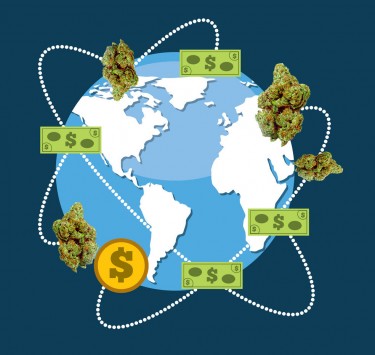
Are you talking about cannabis growers? 50 words every marijuana breeder needs to know
Growing cannabis can be relatively simple, or as complicated as you imagine it to be. To grow cannabis, you just need the proper knowledge to care for the gift of this nature.
Hence, this guide is an attempt to make some of the terms that surround the process of growing cannabis simple. We’ve rounded up some of the key terms cannabis growers around the world use when caring for their plants.
Whether you are a newbie or an expert at growing cannabis, you are sure to learn new terminology in this article. Below are 50 terminologies that every skilled cannabis grower needs to know;
1. Aeroponics
Aeroponics grows plants (in this case, cannabis) in humid environments or in the air without soil. In this planting method, the roots of cannabis are suspended in the air and sprayed with nutrient solution.
2. Apical meristem
Apical meristems are growth tips with a high concentration of meristems (cells that can divide). The apical meristem is responsible for the growth of shoots and roots. Hence, lines should have at least a single apical meristem to encourage growth.
3. Autoflowering
Blooms regardless of the lighting schedule. This trait is inherited from the ruderalis ancestor.
4. ATP (energy molecule)
ATP is an acronym for adenosine triphosphate. It is used by Planar to transfer energy to cells.
5. Auxins
Hormones that modify and regulate plant growth
6. Ballast
The ballast is a lighting device that is used to ignite a lightbulb.
7. Chalice
The calyx is an outer leaf that covers a single flower.
8. Cannabidiol (CBD)
A non-psychoactive cannabinoid is found in cannabis. CBD does not induce “highness” and is also friendly with a number of medicinal benefits.
9. Capillary mats
The capillary mat is a 60 mm (0.25 “) thick, soft polyester material. It is covered with dark polyethylene and has small holes. It is mainly used for watering cannabis and provides exactly the amount of water required by each plant.
10. Chlorosis
Yellowing of the cannabis leaf. A symptom of a lack of chlorophyll in plants.
11. Chlorophyll
The green pigment is present in all plants. It supports the process of photosynthesis by absorbing energy from light to make simple sugars. The chlorophyll is most active under red and blue light.
12. Chloroplast
The chloroplast is a semi-autonomous organelle that houses chlorophyll.
13. Consemilla
Consemilla is a mature cannabis flower that is filled with seeds.
14. cotyledons
These are seed leaves. They are the first pair of leaves to grow during germination.
15. Crimping
Crimping is a method of bending branches when supercropping. This is achieved by damaging the inner tissue, which makes it easier for the plant to bend.
16. Cytokinins
The opposite of auxins. It is a hormone that inhibits plant growth.
17. Fan leaves
Large cannabis leaves that trap light. The fan leaves are a traditional symbol that is often associated with cannabis.
18. Fertigation
Fertigation is the application of fertilizer to the irrigation system. This helps achieve fertilization and irrigation at the same time.
19. Friable
Friable refers to the consistency of the soil. In general, when crumbled into a fist, crumbly soil tends to form a good. But it crumbles quickly if you bump it.
20. Ganja
Ganja is the local slang for marijuana in Jamaica and India. Indian immigrants mainly introduced the term.
21. Gibberellins
Gibberellins are plant hormones that promote the elongation and growth of shoots and leaves. Gibberellins are used by cannabis growers to induce pollination of female plants.
22. Hemp
Hemp is a term used to describe a low-THC strain of cannabis. It is usually grown for oil or fiber.
23. Potash
Traditional Jamaican jargon is used for the best strain of cannabis. It is named after the Indian killer goddess.
24. Light mover
Help with the circular movement of the light or together with teak for better light distribution.
25. Limes
Terpenes are found in citrus peel, cannabis, various flowers, and other fruits.
26. Lumens
A unit of measure for light.
27. Lux
A metric measure of light.
28. Macronutrients
Macronutrients are important nutrients that the plant needs in large quantities. These include potassium (K), nitrogen (N) and phosphorus (P).
29. Micronutrients
Nutrients are needed in plants in small amounts.
30. Myrcene
The most common terpene is found in most strains of marijuana.
31. Necrotic
Lifeless patches of tissue on a leaf.
32nd knot
The junction where a leaf is attached to the stem
33. Organelles
Units within the cell that perform engineering functions
34. Overwinter:
Wintering is a strategy that plants use to survive the winter season. In comparison, insects overwinter as pupae, eggs, or adults, while most plants overwinter as seeds.
35. Photosynthetically Active Radiation (PAR)
PAR is light radiation in the range of 400-700 nanometers.
36. petiole
The prop or stem that connects the blade of a leaf to the steam.
37. Photosynthesis
Photosynthesis is a chemical reaction that takes place in plants. Plants use energy from light to combine Co2 and water to produce simple sugars and give off oxygen.
38. Phytochrome
This is a light, reversible pigment that regulates the flow. Usually in two forms; the dark red and res sensitive.
39. Pinene
PA terpene that smells like pine. It is found in several plants, such as cannabis, sage, eucalyptus, and rosemary.
40th stamp
The organ that carries the egg cell in a flower
41. Rhizosphere
The part of the soil that surrounds the plant roots. It also contains many living microbes and organisms.
42. Ruderalis
Ruderalis is a cannabis strain that doesn’t have to stand in the dark for long to flower.
43. Short day plants
Plants like cannabis that bloom in the dark for a very long time
44. Sinsemilla
A Spanish word that means “without seeds”. It is used to refer to seedless female flowers.
45. Stretching
Stem elongation is a result of heat and poor light.
46. Super cropping
The process of training the upper branches to grow horizontally. This is supposed to help expose the bud to more light.
47. Terpenes
The essential oil is responsible for the different flavors of different cannabis strains.
48. Tetrahydrocannibinol (THC)
The primary psychoactive compound found in cannabis.
49. Perspiration
Perspiration is the loss of water vapor from the cavity of the leaves into the atmosphere. The opening and closing of the stomata is responsible for perspiration.
50. Trichomes
Glands grow from the buds and leaves, which are high in THC.
LEARN THE CANNABIS LANGUAGE, READ MORE …

THE CANNABIS WORDS TO DESCRIBE THE HIGH VALUE!
OR..

THE CANNABIS GLOSSARY WORD GUIDE FOR BEGINNERS (UPDATED)

Post a comment: